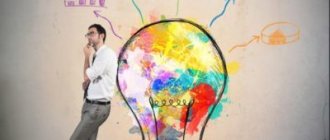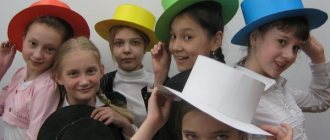Thinking is the main cognitive process that determines much in a person’s life. Associative thinking is a concept that reflects the use of associations: all connections between actions and ideas come from sensations and the traces they leave in the brain. Association is a connection between concepts and ideas that arises in the process of their awareness. One of the ideas evokes another in the mind - this is how associations are born.
Associative connections are not the same for different people, because they depend on personal experience. Thus, one person associates the word “autumn” with slush and bad weather, another – with bright yellow autumn flowers, a third – with a riot of colors in a deciduous forest, a fourth – with mushrooms and “quiet hunting”, a fifth – with loneliness , drizzling rain and a deserted alley stretching into the distance, strewn with withered leaves, and for the sixth - happy birthday, friends, gifts and fun.
The term “association” was introduced by the English philosopher and educator John Locke back in 1698, and has been widely used since then. Thanks to associative thinking, we get acquainted with new things, discover the world for ourselves, expand the boundaries of its knowledge, and learn to think outside the box.
Types of associations
There are different classifications of associations. For example, based on a number of characteristics, the following types can be distinguished:
- Cause - effect (rain - raincoat, lightning - thunder, snow - skis).
- Contiguity, proximity in time and space (sausage - refrigerator, computer - mouse).
- Similarity, similarity of concepts (cloud - feather bed, pear - light bulb).
- Contrast (white - black, fire - ice, cold - heat).
- Generalization (flower - bouquet, birch - tree).
- Submission (vegetable - tomato, bush - viburnum).
- Addition (borscht - sour cream, salad - mayonnaise).
- Whole and parts (body - hand, house - entrance).
- Subordination to one object (pincers - pliers, chair - bench, cup - glass).
There are also associations based on consonance (cat - midge, shadow - fence) and word-forming ones, built on words with the same root (sineva - blue, stove - baking).
In the process of building associations, different senses can be involved, so associations can be gustatory, visual, auditory, olfactory, etc.
What's the benefit?
We need this type of thinking to solve problems, both life and work. And if you engage in its development, pleasant bonuses will await you. For example:
- Improving imagination. Accordingly, you will be able to generate creative ideas, it will be easier for you to meditate and, in general, be creative.
- Strengthening memory. You will remember the material better, since with the help of the created associative series it is quite difficult to forget something.
- Increased productivity. Given the fact that your cognitive processes will become better, you will perform work faster and better.
- Brain stimulation. When an associative series is formed, the brain goes into action, forming new neural connections.
- Ease of perception. It will be easier to perceive new information and adapt to changes.
- Personality research. Even Sigmund Freud, a well-known psychoanalyst, used associations to study what is in a person’s subconscious. In general, you will receive information about yourself that will most likely help you change your quality of life, find answers to important questions and solve complex life problems, and unleash your creative potential.
Many inventions were created thanks to associations. For example, Georges de Mestral came up with the idea of Velcro fasteners after once examining burdock spines under a microscope. He constantly removed them from the fur of his beloved dog after walks. Seeing how interestingly the hooks of this plant were arranged, he had the idea to create such a valuable piece of clothing, shoes, and accessories.
Associative theory of thinking
The first ideas about the universal laws of human mental life were associated with the formation of associations . In the 17th century, the psychology of thinking had not yet been identified as a separate section, and thinking was not considered as a special form of human activity. The development of thinking was understood as a process of accumulation of associations.
The associative theory of thinking is one of the earliest. Its supporters believed that thinking is an innate ability and comes down to associations connecting traces of the past and impressions of present experience. Unfortunately, this theory could not explain the creative nature of the thinking process, the specificity of its content and the patterns of its occurrence.
However, based on the learning process, the associative theory of thinking highlighted several very significant points for the development of thinking:
- The importance of using visual material in the learning process;
- The realization that learning is possible only through sensory knowledge, i.e. through images and representations.
- Understanding that associations expand the boundaries of abilities, through them consciousness is stimulated, activating the processes of comparison, analysis, and generalization.
Some general information
Each person’s associations with one word or event are completely different. This happens due to the life experience that is behind us. For example, when hearing the word “sun,” someone may smile joyfully, remembering the happiest day when the sun was shining brightly and it was warm. And someone, on the contrary, will frown, remembering how he got burns in the summer, in addition to sunstroke due to falling asleep on the beach.
And also due to the difference in the leading representative system. Let me briefly remind you that there are auditory learners; it is easier for them to remember and perceive information by ear. Kinesthetics, they do this with the help of sensations and touches. Visual people rely on their vision, it is important for them to see, only then will they be able to notice and remember something. And also a rare type of digitals, they combined all the features of the representative system, taking a little from each type.
So, we build associations depending on what organs of perception we use to perceive this world and exist in it. Let's say that to learn a phone number, you just need to say it out loud several times. But another person will not be able to reproduce it until he writes it down on a piece of paper, or imagines each number in his head.
Development of associative thinking
Ideas suggested by associations have been successfully used by people for a long time. Observations of fish gave rise to the idea of creating a submarine, and the ascent and submersion systems were inspired by associations with the air bladder of a fish. The idea of echolocation was borrowed from dolphins. The burdock clinging to the dog's fur suggested to Georges de Menstral, an engineer from Switzerland, the principle of creating Velcro, which is now widely used in clothing and shoes. Many unrealized ideas suggested by associations were preserved in the notebooks of Leonardo Da Vinci. Thus, bird observations suggested to him the idea of an ornithopter, which would allow a person to soar above the ground. His sketches of a parachute are a reflection of the dream of a flying man, drifting in the heights, not afraid to fall from any height. And this is only a tiny part of the ideas inspired by associations, and the main thing is that this process cannot be stopped.
Developed associative thinking gives us a number of advantages:
- promotes the development of imagination;
- helps generate new, extraordinary ideas;
- facilitates perception and promotes the formation of new semantic connections;
- improves adaptation to new, non-standard situations and helps in finding solutions to unusual problems;
- stimulates brain function;
- improves memory capacity.
It is impossible not to mention that the basis of mnemonics, which allows you to memorize large volumes of words, are associations. You can learn more about associative memory in our article Associative Memory. Development of associative memory.
It is better to begin the development of associative thinking from early childhood, step by step. First, you just need to introduce the child to all the concepts encountered and the actions associated with them. The next stage is teaching the child to generalize. For example, cups, plates, saucers - dishes; chair, table, armchair - furniture; car, doll, cubes - toys. At the same time, the child learns to name and distinguish objects.
For older children, other, more complex exercises are needed: drawing up associative series, searching for a sequence in a word series, analyzing objects by attribute.
A child’s associative thinking can lead him to psychologically difficult situations. For a parent, in the case when a child reacts sharply negatively to an image or association (for example, vaccination - injection - doctor - white coat), it is important to understand that suppressed associations driven “into a dark corner” can cause the development of various kinds of complexes in the future. It is important to be patient, talk to your child about what scares him, explain, and be positive. You should listen to the child and his associations, try to understand his needs, images, aspirations in order to support the child, reassure him, and restore his sense of security.
Brainstorm. The essence of the method and rules of organization
Published: 02/14/2018
Brainstorming is a method of searching for ideas that was proposed by Alex Osborne (USA) in the 40s. XX century The goal of brainstorming is to generate as many different ideas as possible. The essence of the method is to teach participants not to be afraid of fantastic ideas: they are easier to “tame” than to come up with. This method awakens tired imaginations. The main provisions of the method: collective search for ideas, separation […]
no comments yet
Exercises for developing associative thinking
Want to try association games? This is the case when games develop:
- Take any two words that are not related in meaning, and try to gradually create a semantic associative chain leading from one to the other. For example: a car and a tree. The chain could be like this: car – road – forest – tree.
- Think of a few words (for example: bottle, beads, window). Choose association words for them that are similar in one or more characteristics (for example: glass, hard, sparkling, green).
- Choose associations that unite all the words at the same time. For example: cold, shiny - ice, diamond, metal.
- If you are on a walk or on the road, and you have a travel companion, come up with any first word and, in turn, lead a chain of associations from it. When an association is not clear, explain its appearance. It's fun, interesting and develops associative thinking.
- Come up with unusual associations. For example, wallet - money is a common, expected association. What else can you keep in your wallet? A lottery ticket, a lock of hair, an amulet, a note, a key?
- There is an interesting test that does not take much time, but allows you to play with associations and look into your subconscious and understand what is bothering you. This is the first step towards a solution, right? You can simply come up with 16 any words, or you can use auxiliary initial letters. But you shouldn’t think for a long time, you need to write the first thing that comes to mind and be honest with yourself (if your goal is to get to know yourself better and solve your problem). You can use nouns, adjectives, adverbs, phrases. So, if you decide to use letters (it’s easier to start with), take a piece of paper and write down the following letters vertically on the left: t, d, b, m, g, a, g, o, k, p, c, n, z , p, l, s. Now, opposite each of them, write a word starting with that letter - the first one that comes to mind. Now take the resulting words in pairs, selecting an association for every two consecutive words running vertically. Write down associations next to each pair of words. You will get 8 words. Then again, vertically from top to bottom, combine the two resulting words and again write down the emerging associations. Now there will be 4 of them. Combine them in pairs, write down two new associations. By combining them, you get the key association, the most important one. Associations helped in the study of the subconscious, they were used by S. Freud, then by C. Jung, and are still used by many psychoanalysts (and not only to this day). By using the creative component of your personality, during such a test you can look into your subconscious and find ways to solve the problem, if any. In any case, by putting associations and thoughts on paper, we subject them to analysis, look deeper into ourselves and understand better.
Psychodiagnostic methods using associations
Since the beginning of the 20th century, connections spontaneously arising in the cerebral cortex have been used by psychologists to diagnose human mental states. S. Freud was the first to draw attention to the connection between free associations and processes occurring at the level of the unconscious. According to his theory, at this deep level of the psyche there are instincts and desires suppressed by a person, which contradict the requirements of society.
But having driven these forbidden desires into the far corner of the unconscious, a person did not get rid of them. They continue to influence his behavior, provoke phobias or strange behavior, and even cause mental disorders and organic diseases.
Free association method
Associations that arise involuntarily carry information about these suppressed desires and instincts, which allows a psychologist or psychiatrist to make a diagnosis. For this, S. Freud developed and began to use the method of free association, which to this day is one of the main ones in psychoanalysis.
The principle of this method is very simple. Having assumed a comfortable position and relaxed, the patient should simply say whatever comes to his mind. He can talk about his problems, or he can simply reflect on the meaning of life or discuss his colleagues. You need not to control, not to analyze, not to choose the right words, but to speak freely.
The patient’s thoughts and words themselves evoke different associations in his mind, generating a new stream of speech activity and pulling out from the unconscious what is hidden there and interferes with life. But the psychoanalyst must recognize the connection between individual phrases, words, and reservations of the patient and his psychological problems and complexes, identify these problems and reveal their essence to the client.
Variety of association methods
Currently, associative thinking is used in many psychodiagnostic techniques that make it possible to study the characteristics of an individual’s mental state, his problems, experiences and attitude towards others. Unlike Freud and his followers, representatives of other psychological movements prefer to use not free associations, but more organized and controlled by a psychotherapist. The methods are developed in such a way as to not only stimulate the emergence of associations, but also to be able to statistically process the results and compare them with data from other clients. All such diagnostic methods can be divided into three groups of tests:
- Based on verbal associations. In such tests, subjects are presented with a series of words or phrases, in response to which they must say the first thing that comes to mind. The very formulation, meaning, and scope of use of phrases are designed to reveal the internal problems of the person being diagnosed. One of the most popular such techniques is the “Paired Associations” test.
- Based on visual associations. Looking at the proposed pictures, often abstract, the client must say what they remind him of. The most famous of these techniques are the Rorschach Ink Blot Test and metaphorical cards.
- Based on the analysis of creative products. In order to study unconscious associations, the diagnosed person is asked to complete a creative task, for example, write an essay on a given topic or draw something. The creative process frees thinking and connects the subconscious to the process, which facilitates the birth of associations and opens access to archetype images, hidden desires and poorly understood problems.
Associative thinking is not only a source of important information about a person, it is a necessary condition for the intellectual and creative development of the individual.
Impaired associative thinking
Violations of associative thinking are expressed in changes in its pace, focus and harmony. Serious painful disorders of associative thinking are the subject of study in the literature on psychiatry and clinical psychology, in the section of psychopathology.
Some patterns of disturbances in the thought process were identified. Based on the symptoms of disorders, disorders are divided, for example, into form and content. In the first case, we are talking about violations of the associative process of thinking (the way a person thinks), and in the second - violations of judgment (what a person thinks, various kinds of obsessive states, delusions, super-black ideas). Below we will consider only some types of disorders of associative thinking:
1. By changing the pace of thinking:
- Acceleration, a noticeably faster pace of processing information, generating ideas, making decisions, and sometimes a leap of ideas. This acceleration is characteristic of manic states.
- Slowing down the pace, excessive delay in thinking and making decisions.
- An involuntary intrusion of thoughts (mentism), interfering with the thought process, leading off the topic.
- Stopping thinking is a break in the flow of thoughts, their involuntary stop.
2. By mobility, liveliness of the thinking process:
- An abundance of detail, minor details, unimportant to the topic.
- Excessive thoroughness, aggravating the previous point with unnecessary distracting associations and details.
- The viscosity of thoughts, in which thinking ceases to be productive, the thread of conversation is lost.
3. According to the grammatical structure of speech:
- The use of cliches, ready-made cliches, templates or questions when constructing an answer, that is, the use of speech stereotypes.
- Repeating meaningless words, sounds or phrases.
- Incoherent repetition of words or their combinations, in which there is no logical or grammatical structure.
4. By focus:
- Excessive ornateness when expressing a simple thought.
- Slipping off the topic into a lengthy discussion on an abstract association, followed by a return to the topic.
- Verbose empty and lengthy ranting without purpose, “about nothing” (reasoning).
- Directing efforts not at resolving the issue, but at executing the protocol (formalism).
- Consideration of an issue from different angles, with different evaluation criteria, changing levels of generalization, which makes it impossible to make a final decision (diversity).
- Fuzzy, contradictory use of concepts, when it is almost impossible to understand what is being said (amorphousness).
- Violations of the logic of thinking, in which either premises, or cause-and-effect relationships, or evidence suffer.
- Symbolism that is understandable only to the patient himself, and to no one else.
- Pathological finding of new meanings in words, based, for example, on the number of letters or on their rhyming with one or another (for example, “happy” or “unlucky”) word.
- Autistic thinking is one that concerns only the patient’s inner world, closed to outsiders.
- Archaic thinking - it is based on ancient stereotypes, judgments, views that are far from modernity.
- Perseveration (persistence, persistence) - in this case, a person persistently repeats words, phrases or deeds, even if the relevant context has already been exhausted.
- Discontinuity (lack of logical connection between concepts, judgments and conclusions), although the grammatical structure of speech may not be disrupted.
To keep the brain in good shape, the comprehensive development of its cognitive functions, such as attention, thinking, memory and perception, is important. To develop them, you can use regular classes with the help of exciting online games performed in the form of exercises for the development of thinking in adults.
We sincerely wish you a useful and exciting pastime and success in self-development!
Experiment
The ideas of Hartley and Hume, as well as other representatives of associative psychology, migrated to other directions and became the basis for new research.
One of these was the associative experiment in psychology, its development was carried out by E. Kremelin, K. Jung, W. Wundt and other researchers. This method is used both to study the interaction of people in a group and to study the internal processes of an individual. Thanks to the dynamics that are set in the experiment, the subject makes involuntary associations. And they are the basis for studying the thought process of both a given person and a group of people.
We recommend: Define your archetype
The association experiment is widely used in various fields of psychology to obtain reliable information:
- It is used as a method of speech analysis, namely to study the vocabulary of the subject. To do this, subjects are presented with a list of words (about a hundred) and are asked to write their own association for each word (the first word that comes to mind) - no more than 10 minutes are allotted for this experiment.
- It is also used in psychophysiological studies to assess the correct understanding of stimuli. For example, a subject is presented with a certain stimulus (usually a word) and attention is paid to his physiological reaction - for example, how quickly the subject begins to salivate after the researcher says the word “lemon”.
- As a method of analyzing interaction within a group, to understand who is the leader and who is the outsider, as well as how cohesive the group is.
- It is interesting that the experiment in question is also actively used in criminology: with the help of associations, a suspect’s involvement in a particular crime is determined. In such cases, “reliable” are those associations that the suspect makes immediately, without thinking, since thinking can lead to false data.
As you can see, this experiment is used quite widely and in completely different areas of modern psychology. We should not forget that in many ways associations demonstrate not only the conscious part of our psyche, but also the subconscious. It is not for nothing that this method was used by psychoanalysts, whose subject of study was our unconscious.
Types
They are distinguished by:
- similarities: sled – skis – snowboard.
- contrast: white - black, boy - girl.
- the relationship between the whole and its parts: finger - nail, phone - screen.
- cause-and-effect relationship: clouds - rain, fire - fire.
- generalization: shoes are footwear, earrings are decoration.
- subordination: watermelon - berry, maple - tree.
- contiguity of space or time: winter - cold, newspaper - magazine.
- addition: butter - salad, soup - bread.









